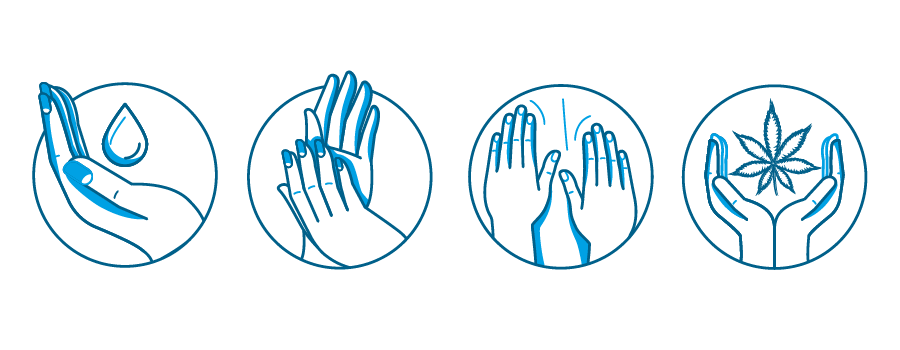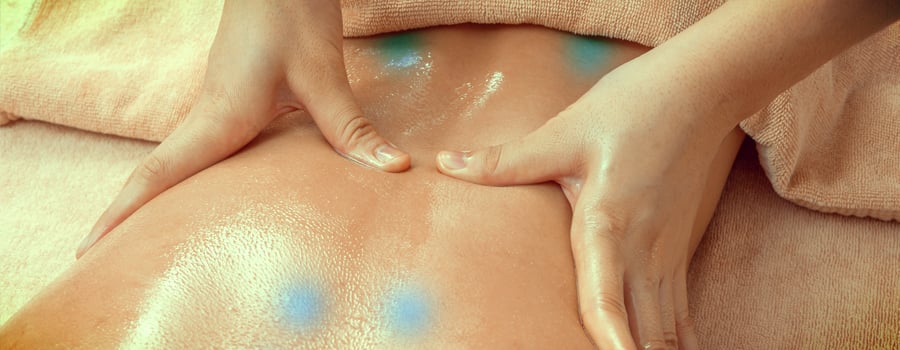.

Find Out How Massage and Cannabis Combine
Cannabis and massage are both techniques that have been used far back into history in order to treat conditions such as pain. Both modalities work effectively when used in isolation, however some therapists are now using them in combination and reporting powerful effects.
What do cannabis and massage have in common? At first, this question might seem quite strange and yield no answers, but digging a little deeper it is apparent that these two fields are capable of creating a synergistic relationship to be utilised by therapists. Both are ancient methods of targeting pain, boosting relaxation and enhancing mental states. First, let’s explore the pain relieving and positive aspects of each form of therapy, and then learn how they have the potential to work so well together.
MASSAGE AS MIND AND BODY MEDICINE
Massage is a manual therapy used by therapists to physically manipulate the soft tissues of a patient's body in order to treat pain and enhance relaxation. Several forms of massage exist, with each technique acting in a slightly different way. For example, Swedish massage focuses on circular movements and strokes. Comparatively, deep tissue massage and trigger point massage works deeper into the tissue and is often used to target contracted trigger points within the tissue.
There are various theories on why massage produces its intended effects. One of which is named gate theory, that proposes the therapy manages to inhibit pain signals being sent to the brain. Other theories propose that massage enhances the levels of endorphins and serotonin within the body, therefore triggering these effects. As of now, there is no clear mechanism of why massage achieves its effects.
A paper titled Massage Therapy Effects published in the journal American Psychologist discusses the form of treatment in great detail. It touches upon massage's ancient past, stating how it is indeed one of the oldest forms of treatment in the world, having had a large place in China and Egypt and having been recognised by Hippocrates as “the art of rubbing”.
The author of the paper explains, “massage therapy has recently received empirical support for facilitating growth, reducing pain, increasing alertness, diminishing depression, and enhancing immune function”. Now that is quite an impressive list of benefits, many of which span past the easing of pain on the specific muscle being worked.
Another scientific paper[1], titled The Impact of Massage Therapy on Function in Pain Populations, discusses the problems of pain and how massage can play a role.

The authors of the paper explain how pain is a large health problem within society and is the most common reason why a person will seek medical help, accounting for a massive total of 80% of visits to a doctor. Pain is not only a physical detriment, but its effects can trickle into and affect the domains of mental, emotional and spiritual health. This is yet another reason why cannabis and massage work so well together, as we are going to find out.
The researchers state that massage is an effective treatment for pain, especially when compared to patients who had no treatment at all, with very few side effects.
Further studies[2] suggest that massage may be effective at reducing anxiety, blood pressure, heart rate and possibly even depression and pain.
CANNABIS AS A POTENT PAINKILLER
So this is where cannabis steps into the picture as a powerful herbal agent that can potentially assist the pain-taming effects of massage. Perhaps one of the better-known uses of medical cannabis is its effects against chronic pain. Cannabis has a similarity with massage in that its use as a medical treatment spans far back into history, having been used in China from 2700 BC and India from 1000 BC. Cannabis plants produce a resin that is loaded with chemicals known as cannabinoids. One of which, and perhaps the most well known, is THC, the cannabinoid responsible for the “high” obtained from smoking cannabis.
However, THC is not the only cannabinoid worth mentioning when it comes to medicinal uses and chronic pain. Other members of this molecular family include CBD, CBN, THCV and CBC. These cannabinoids affect the body in different ways via specific receptors that make up the endocannabinoid system.
Cannabinoids have been shown to help relieve certain kinds of pain. For example, neuropathic pain is a chronic state of pain that is usually accompanied by injury to tissues. A paper[3] published in the journal Current Medical Research and Opinion documents a study in which aimed to review data associated with cannabis and pain relief.
The study involved administering a dual CBD and THC spray for neuropathic pain associated with MS, serving as an important step in the field of cannabis and pain research.
Another paper, published in the European Journal of Pharmacology, assessed the effects of CBD[4] against chronic inflammation in rat models of neuropathic pain.
On top of these forms of scientific evidence, it is a well-known anecdotal experience that people suffering from many different types of medical conditions find relief from pain when they ingest cannabis.
Although many studies feature cannabis that has been smoked, it may create some confusion as to how effective cannabis will be for pain when applied topically during a massage. Well, we now live in an age where prohibition is being battled back, creating space for innovation in a now booming industry. All kind of topicals now exist, from creams to sprays to oils. These products may help to relieve localised pain and inflammation, making them perfect when receiving a massage for this purpose.

CANNABIS AND MASSAGE, A PERFECT MATCH?
When cannabis topicals are used during a massage, they work their magic by targeting cannabinoid receptors in the body. Whether the products contains CBD or THC as the cannabinoid of choice, most topicals will not induce a high as they fail to enter the bloodstream effectively - focusing where they are locally applied. However, some transdermal products will have psychoactive effects.
When using topicals for massage, there seems to be an almost limitless way to blend them with other botanicals to create a mixture perfect for specific patients. For example, shea butter may nourish the skin, whilst peppermint may create a cooling effect. Other botanicals that help to relieve pain may also be added to an assortment of creams and oil that therapists can utilise to achieve the best results possible.
If one of the main applications of massage is to physically manipulate soft tissue in order to remove or temporarily relieve painful sensations, and cannabis can play a role as an apparent herbal pain killer, then it only makes sense that the two have the potential to work perfectly together.
With its recent legalisation in certain areas of the world, cannabis seems to be revolutionising various elements of healthcare, and it appears massage and physical therapies may very well be on this list also.
- Impact of Massage Therapy on Function in Pain Populations—A Systematic Review and Meta-Analysis of Randomized Controlled Trials: Part I, Patients Experiencing Pain in the General Population | Pain Medicine | Oxford Academic https://academic.oup.com
- Massage Therapy: Get Facts about Types and Benefits http://www.medicinenet.com
- Meta-analysis of Cannabis Based Treatments for Neuropathic and Multiple Sclerosis-Related Pain - PubMed https://www.ncbi.nlm.nih.gov
- The Non-Psychoactive Cannabis Constituent Cannabidiol Is an Orally Effective Therapeutic Agent in Rat Chronic Inflammatory and Neuropathic Pain - PubMed https://www.ncbi.nlm.nih.gov









































